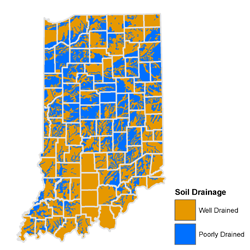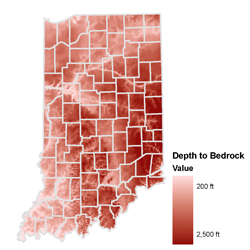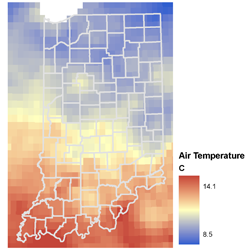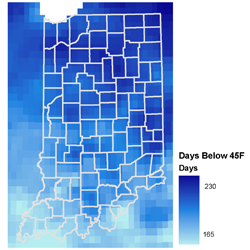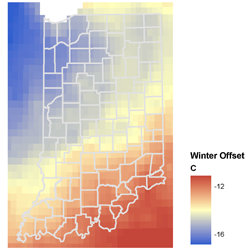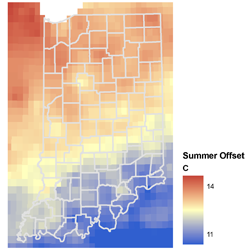What is a Geothermal Heat Pump?
A geothermal or ground-to-air heat pump operates by exchanging heat between the air in your house and the ground. An air conditioner removes excess heat from your home by using it to evaporate a refrigerant (e.g. Freon or a modern equivalent), it uses a compressor to force the refrigerant back into what is now a hot liquid, this is then pumped to an outside unit where excess heat is vented to the surrounding air and the cooled refrigerant is returned to the house to repeat the process. A heat pump allows for this process to be reversed, so excess heat from the air is pumped into the home. This process can be very efficient while air temperatures exceed 45F to 50F at which time supplemental heat (often electric) is required. The geothermal or ground-to-air heat pump simply buries the external unit so that it exchanges heat with the ground instead of the air. This takes advantage of the relative stability of ground temperatures - think about a cool basement on a hot summer day. Ground temperatures for much of the United States do not fall below the cut-off for efficient heating with a heat pump and so it makes for a very good option for the heating and cooling of your home.
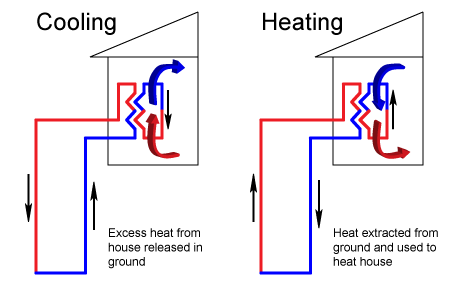
Types of Geothermal Heat Pumps
Geothermal heat pumps come in many forms. Within the home they can be used to heat or cool air (ground-to-air) and can then replace a traditional forced air central heating and cooling system. They can also be used to heat water (ground-to-water), which can replace boilers, radiant heating systems or other methods of distribution. Hybrid systems are also possible, which will provide hot air and water so that both forced air and radiant systems or a water heater can be supplied from the same system.
Geothermal installations can make use of open- or closed-looped systems. An open loop system pulls water from a source such as a lake, river or groundwater and returns it to the source once it has been used for heating or cooling. Closed-loop systems pump a liquid, usually water with a small amount of eco friendly antifreeze, through a closed heat exchanger buried in the ground or submerged in a large body of water.
For closed-loop underground systems the heat exchanger can be installed horizontally of vertically. The horizontal installation typically involves trenches dug to about 6 ft and filled with pipes (could be straight or coiled) that provide the surface area required for the exchange of heat between the soil and the fluid used by the heat pump, once the holes have been refilled. This option requires a lot of space (depending on installation a trench may need to be 100 ft or more in length and several feet in width for every ton of heating and cooling required), but is generally less expensive than the vertical system because the equipment for trenching is more common. The vertical system requires vertical holes to be drilled, a single loop of pipe installed and the hole backfilled. For each ton of heating and cooling, one shaft of about 150 m depth will be required, however, the holes can be drilled relatively close together so the total area required is very small. This is a good option for updating existing homes with landscaping or limited yard space, but extra costs can be incurred because of the need for drilling equipment.
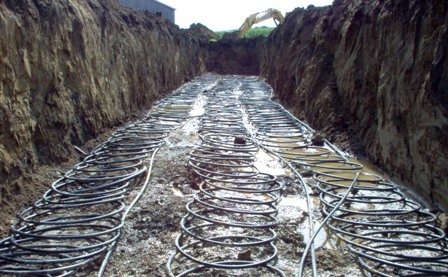
Geothermal Heat Pump Efficiency
So why consider a geothermal heat pump? Because they are exceedingly efficient at what they do. Modern heating systems that burn a fuel hover around 95% efficiency, but a heat pump requires only pumps and a compressor which require far less electricity than an electric heat and can reach efficiencies of up to 400%. With gas and oil prices high the investment in a geothermal system can really pay off. Plus the ground components are very simple and typically warranted to between 25 and 50 years, and likely to last much longer so once the investment is paid off the system should run with only regular maintainance for a long time.
Our geothermal system was installed in January 2008. Energy use averages presented here are based on incomplete data, as we do not have a complete record of nergy usage prior to installation. From our analysis
- Total home energy use (electric and gas) was less in both winter and summer 2008;
- Gas use was much less in both time periods (only used for cooking);
- Electrical use increased in winter (back-up heating);
- Electrical use decreased in summer (perhaps due to more efficient circulation or lower cooling needs);
- Average heating needs were about the same in 2008;
- cooling degree days were less.
| Winter | Summer |
|---|---|
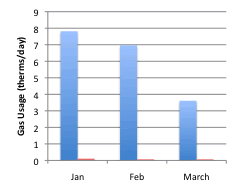 |
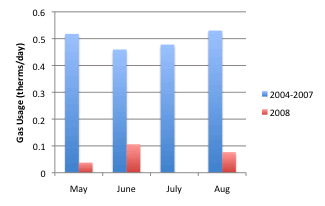 |
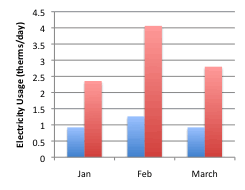 |
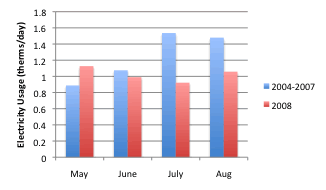 |
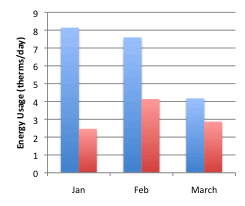 |
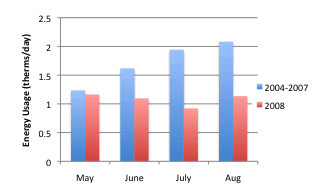 |
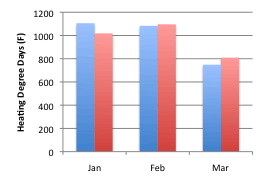 |
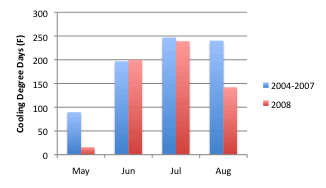 |
Installation of the Heat Pump
Our Geothermal heat pump was installed between November 2007 and January 2008. There were some weather related delays, but the system was installed in a timely manner and with minimal intrusion into our daily lives.
| The old natural gas furnace. The old gas water heater has already been replaced with a new electric model, with the intention of using excess heat from the ground heat pump to boost water temperatures. | |
| Drilling of one of the bore holes in underway. | |
| Drilling of one of the last boreholes. | |
| A look at a recently completed borehole. | |
| Here the drilling crew is feeding a ground loop into a completed bore hole. A simple u-bend connector used to complete the loop at the bottom of the hole. The pipes being fed down are each continuous, pieces minimizing the likelihood of failure along the length of pipe. | |
| The drilling is complete. Here you can see two pipes emerging from the ground surface above each of the four holes. | |
| A look at the trench excavation. Excavation had to be put on hold as the weather turned problematic. | |
| Pipes from the ground loop lying at the bottom of the excavated trench. Boreholes to the right, the house to the left. | |
| External connections for tee ground loop. The four ton system is connected to four holes, each with an inflow and an outflow. | |
| Inside the basement, the ground loop is connected to the heat pump. Fluid is pumped out to the left and returns to the right, with the first hole out on the left is the last one back on the right. | |
| The Geothermal heat pump has now been installed and is fully connected and functional. | |
| A peak inside the Geothermal unit. | |
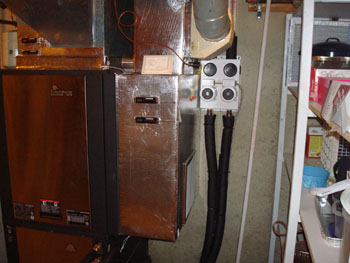 |
Connections between the Geothermal heat pump (down) and the ground loop (up). |
| Connections between the Geothermal heat pump (to the right) and the water heater (center). Excess heat from the heat pump is used to boost water temperatures. |
We would like to thank our contractors: F&S Williams of Lafayette, Indiana
Other contractors in the Lafayette Area include:
Potential for Geothermal heat pumps in Indiana
- Vertical systems require about 46 m (150 feet) of soil depth above bedrock;
- Horizontal systems are well-suited to poorly-drained soils;
- Geothermal heat pumps will work best where there are larger air to ground temperature off-sets; and
- Conventional (air to air) heat pumps are ineffective below approximately 7C (45F);
Closed loop geothermal heat pumps work best in wet soil conditions, as it improves heat transfer between the ground loop and the soil. Poorly drained areas may provide additional benefit to horizontal loops. |
Vertical systems require boreholes to a depth between 150 and 250 ft. The depth for any specific borehole is not as important as the total depth acheived with the set of boreholes. To minimize costs, fewer deeper holes are better. |
The effectiveness of a geothermal heat pump is related to the difference in temperature between the soil and the house. This figure shows annual average air temperature for 1950-1999. |
Air source heat pumps, those that are installed outside a house similar to the installation of an air conditioner, are effective for heating only when air temperatures are above 45-50F. |
This figure shows the offset between average January air temperatures and annual average annual air temperatures. |
This figure shows the offset between average July air temperatures and annual average annual air temperatures. |
